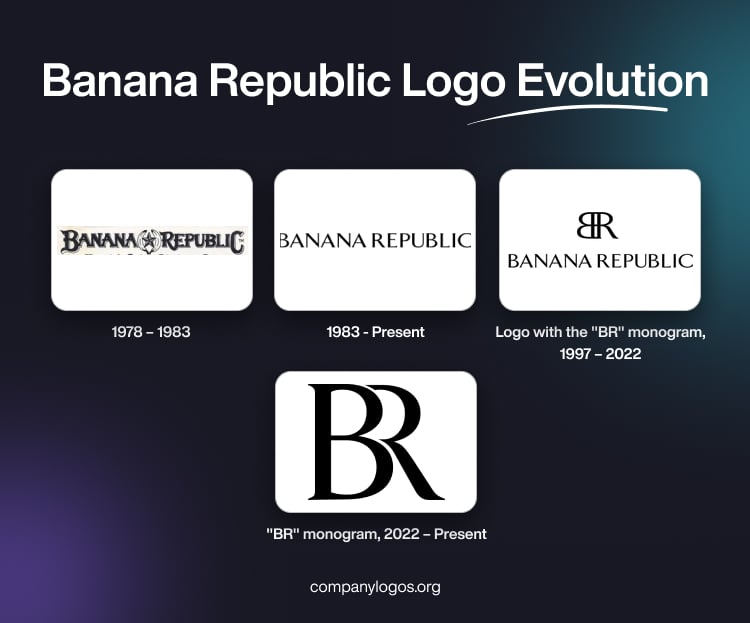
Established in 1978, Banana Republic is a popular US-based high-end apparel and accessory brand. Initially, the company was known as Banana Republic Travel and Safari Clothing Company. It was later changed to Banana Republic after being acquired by Gap. Just as a brand has changed over time, so too has its visual identity.
This article explores the fascinating origins and development of the Banana Republic emblem. It traces the origins of the brand, from a clothing business with safari-inspired designs to a worldwide fashion icon, among other details.
The Genesis of the Banana Republic Logo (1978 – 1983)
The logo of Banana Republic originally captured the essence of exploration and adventure. The original design had a hand-drawn style that emphasised the creators’ individuality and the brand’s dedication to genuineness. The logo featured the brand name written using a contoured and fancy old-style uppercase typeface.
The black lettering had grey shadows, which made them appear three-dimensional. At the centre of the brand name was placed an emblem made of a cool star comprising five banana-shaped strokes. The stylish first and last letters of the brand name were bigger than the rest.

(1983 – Present)
The latest logotype in black and set against a white background is minimalist. It is written using a thin and light serif typeface. The serifs of the letters are sharp and can be compared with the thorns on a rose. The overall logo looks distinctive and elegant, and the serifs represent the brand’s approach to style.

(1997 – 2022)
The 1997 logo comprised an emblem or monogram and a logotype in monochrome. The emblem was made by combining the letters “B” and “R” where “B” was reversed. Underneath the emblem was written the brand name using a serif typeface similar to the previous one.

(2022 – Present)
In 2022, the “BR” monogram was changed, while the logotype was retained. The thick letters “B” and “R” with sharp serifs were placed together and the vertical bar of “R” was removed. In fact, the letter “R” appeared to be an extension of the letter “B” and enveloped it in a cosy embrace.

The Elements of the Banana Republic Logo
Font
The wordmark of the Banana Republic logo is written in a sans-serif typeface, which bears a striking resemblance to the Seta Reta NF Regular typeface. Besides, TFArrow-Medium also shares some similarities, particularly in certain glyphs.
Colour
The colour palette of the Banana Republic logo is black and white, where black represents the brand name, while white acts as the background. The colour choice is to enhance legibility and to make the logo instantly recognisable amidst competition.
The History of Banana Republic
Banana Republic was founded in 1978 by Mel and Patricia Ziegler, a husband-and-wife team in California. The journalist couple had a passion for travel and began selling unique, safari-style clothing inspired by their journeys around the world. They opened the first Banana Republic store in Mill Valley, California, wherein they curated a collection of surplus military apparel, exotic travel gear, and rugged adventure wear. The stores were decorated with a strong safari and exploration theme. Complete with Jeeps and props, the stores gained popularity for their imaginative catalogues filled with hand-drawn illustrations.
In 1983, Banana Republic was acquired by Gap Inc., which sought to expand the brand’s reach and reposition it in the broader fashion market. Under Gap’s ownership, the company moved away from its niche safari and travel-inspired offerings and was rebranded as a more upscale fashion retailer. The catalogues were gradually phased out, and the adventurous store themes were replaced with a more polished, urban style.
Over the eighties and nineties, Banana Republic evolved into a destination for sophisticated, business-casual apparel. It developed a reputation for offering modern, versatile pieces that appealed to young professionals. The brand positioned itself between the casual accessibility of Gap and the luxury of higher-end fashion houses. It became a go-to for workwear staples like tailored suits, dresses, and stylish basics.
In the early 2000s, Banana Republic expanded internationally by opening stores across Asia, Canada, and Europe. The brand also broadened its product line to include accessories, footwear, handbags, fragrances, and even home goods. Its emphasis was on offering affordable luxury with classic yet contemporary design.
By the 2010s, Banana Republic faced challenges as consumer preferences shifted toward fast fashion and online shopping. Sales declined, and the brand struggled to differentiate itself in a competitive retail landscape. In response, Gap Inc. began repositioning Banana Republic once again. It emphasised higher-quality materials, more fashion-forward designs, and a return to some of its adventurous roots. The company experimented with collaborations, limited-edition collections, and digital innovation to revive its image.
During the COVID-19 pandemic, the brand—like many retailers—faced store closures and restructuring. However, post-pandemic, Banana Republic has sought to re-establish itself as a modern lifestyle brand. It focuses on creating timeless, sophisticated designs and keeping its heritage of fashion inspired by exploration.
Interesting Facts About Banana Republic
- The brand began in 1978 as a quirky travel- and safari-inspired clothing company. Its first stores had jungle-themed décor, Jeeps inside the shops, and products like surplus military jackets and expedition-style clothing.
- Founders Mel and Patricia Ziegler created illustrated catalogues that looked more like travel journals than retail ads. They became cult favourites for their adventurous storytelling and imaginative designs.
- In 1983, just five years after it was founded, Banana Republic was purchased by Gap Inc. This transformed the brand from a niche safari outfitter into a polished, upscale fashion house.
- The term “banana republic” is politically charged. It was originally used to describe politically unstable countries dependent on limited agricultural exports. Despite its controversial undertones, the Zieglers used the name playfully to reflect their adventurous theme.
- At its peak, Banana Republic operated stores across North America, Europe, and Asia. It became a symbol of accessible sophistication for professionals worldwide.
- Banana Republic was designed to fill a “gap” between Gap’s casual basics and luxury fashion houses. It offered tailored suits, dresses, and accessories at mid-level prices.
- Over the years, the brand has collaborated with designers and cultural institutions. These include special Mad Men-inspired collections and even costume tie-ins with film and television.
- In recent years, the brand has revisited its adventurous roots by creating collections inspired by exploration, travel, and rugged sophistication.
- Banana Republic is part of the Gap Inc. family, which also includes Gap, Old Navy, and Athleta. It gives the brand a unique spot in a diverse portfolio of global fashion brands.
- After selling Banana Republic, the Zieglers went on to create other ventures, which include the clothing brand The Republic of Tea, thereby showing their knack for lifestyle branding.
Finally
The evolution of the Banana Republic logo reflects the transition of the company from a specialised merchant with a safari motif to a well-known figure in the fashion world. Each logo version captures the dedication of Banana Republic to remain current while maintaining its unique personality.